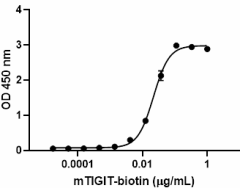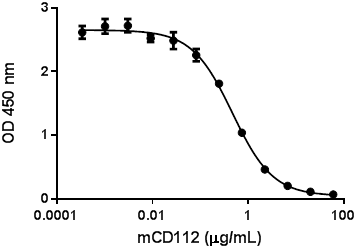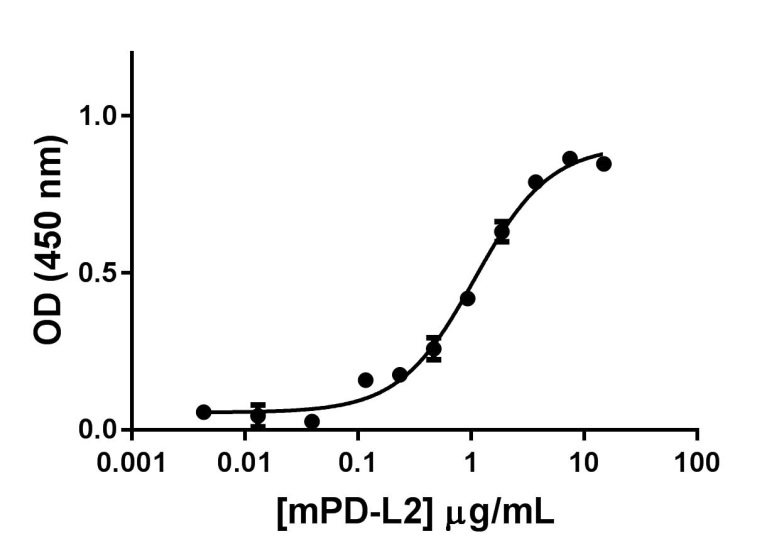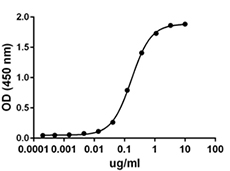- Regulatory Status
- RUO
- Other Names
- PVR, PVS, Nectin-like molecule-5, Nectin-like protein 5, NECL5, NECL-5, Poliovirus receptor
- Ave. Rating
- Submit a Review
- Product Citations
- publications

-

When mouse CD155-Fc Chimera is immobilized at 2.0 µg/mL, biotinylated mouse TIGIT-Fc Chimera binds with an EC50 of 10 - 40 ng/mL. HRP Avidin (Cat. No. 405103) was used to detect the binding. -

Stability testing for mouse CD155-Fc Chimera. Recombinant mouse CD155-Fc Chimera was aliquoted in PBS, pH 7.2 at 0.2 mg/mL. One aliquot was frozen and thawed four times (4x Freeze/Thaw), and compared to a control kept at 4°C (Control). The samples were tested in a binding assay with biotinylated mouse TIGIT-Fc Chimera.
CD155, also known as TAGE4 or NECL-5 (nectin-like molecule-5), was originally described as a poliovirus entry receptor (PVR) more than 30 years ago. CD155 is a 70 kDa type I transmembrane glycoprotein that belongs to the nectin-related family of adhesion molcules within the immunoglobulin superfamily, defined by the presence of immunoglobulin domains V, a C1-like domain and a C2 domain in the extracellular region. CD155 binds several molecules including Vitronectin, Nectin-3, DNAM-1/CD226, CD96, and TIGIT. All bindings are mediated by the V-type domain and alternative splicing within this domain can modulate ligand binding. CD155 is highly expressed on tumor cells of epithelial and neuronal origin. It's enhanced expression in these tumors contributes to the loss of contact inhibition leading to increased migration, however, tumor cell recognition and killing by NK cells are also enhanced via DNAM-1 or CD96 expressing NK cells. CD155 normally functions in the establishment of intercellular adherens junctions between epithelial cells. CD155 mediates NK cell adhesion and triggers NK cell effector functions by binding to CD96 and CD226. These interactions accumulates at the cell-cell contact site, leading to the formation of a mature immunological synapse between NK cell and target cells.
Product DetailsProduct Details
- Source
- Mouse CD155, amino acid Asp29 - Leu348 (Accession # NM_027514.1), with a C-terminal hIgG1 Fc tag was expressed in 293E cells.
- Molecular Mass
- The 559 amino acid recombinant protein has a predicted molecular mass of approximately 61.7 kD. The DTT-reduced protein migrates at approximately 80 kD and non-reduced protein migrates at approximately 160 kD by SDS-PAGE. The predicted N-terminal amino acid is His.
- Purity
- > 95%, as determined by Coomassie stained SDS-PAGE.
- Formulation
- 0.22 µm filtered protein solution is in PBS, pH 7.2.
- Endotoxin Level
- Less than 0.01 ng per µg cytokine as determined by the LAL method.
- Concentration
- 10 and 25 µg sizes are bottled at 200 µg/mL. 100 µg size and larger sizes are lot-specific and bottled at the concentration indicated on the vial. To obtain lot-specific concentration and expiration, please enter the lot number in our Certificate of Analysis online tool.
- Storage & Handling
- Unopened vial can be stored between 2°C and 8°C for up to 2 weeks, at -20°C for up to six months, or at -70°C or colder until the expiration date. For maximum results, quick spin vial prior to opening. The protein can be aliquoted and stored at -20°C or colder. Stock solutions can also be prepared at 50 - 100 µg/mL in appropriate sterile buffer, carrier protein such as 0.2 - 1% BSA or HSA can be added when preparing the stock solution. Aliquots can be stored between 2°C and 8°C for up to one week and stored at -20°C or colder for up to 3 months. Avoid repeated freeze/thaw cycles.
- Activity
- When mouse CD155-Fc Chimera is coated at 2.0 μg/mL (100 μL/well), biotinylated mouse TIGIT-Fc Chimera binds with an EC50 of 10 - 40 ng/mL. HRP Avidin (Cat. No. 405103) was used to detect the binding.
- Application
-
Bioassay
- Application Notes
-
BioLegend carrier-free recombinant proteins provided in liquid format are shipped on blue ice. Our comparison testing data indicates that when handled and stored as recommended, the liquid format has equal or better stability and shelf-life compared to commercially available lyophilized proteins after reconstitution. Our liquid proteins are verified in-house to maintain activity after shipping on blue ice and are backed by our 100% satisfaction guarantee. If you have any concerns, contact us at tech@biolegend.com.
Antigen Details
- Structure
- Disulfide-linked homodimer
- Distribution
-
CD155 is highly expressed on immature thymocytes, lymph node dendritic cells, and tumor cells of epithelial and neuronal origin. It is preferentially expressed on Th17 cells.
- Function
- Mediates NK cell adhesion and triggers NK cell effector functions.
- Interaction
- NK cell, T cell
- Ligand/Receptor
- Vitronectin, Nectin-3, DNAM-1/CD226, CD96, and TIGIT.
- Bioactivity
- Measured by its ability to bind biotinylated mouse TIGIT a functional ELISA.
- Cell Type
- Dendritic cells, Th17, Thymocytes
- Biology Area
- Adaptive Immunity, Cell Adhesion, Cell Motility/Cytoskeleton/Structure, Neuroscience
- Molecular Family
- Adhesion Molecules, Soluble Receptors
- Antigen References
-
- He Y, et al. 2000. Proc. Natl. Acad. Sci. USA. 97:79-84.
- Bottino C, et al. 2003. J. Exp. Med. 198:557-67.
- Fuchs A, et al. 2004. J. Immun. 172: 3994-3998.
- Reymond N, et al. 2004. J. Exp. Med. 199:1331-41.
- Koike S, et al. 1990. EMBO J. 9: 3217-3224.
- Mendelsohn CL, et al. 1989. Cell 56:855-65.
- Gene ID
- 52118 View all products for this Gene ID
- UniProt
- View information about CD155 on UniProt.org
Related FAQs
- Why choose BioLegend recombinant proteins?
-
• Each lot of product is quality-tested for bioactivity as indicated on the data sheet.
• Greater than 95% Purity or higher, tested on every lot of product.
• 100% Satisfaction Guarantee for quality performance, stability, and consistency.
• Ready-to-use liquid format saves time and reduces challenges associated with reconstitution.
• Bulk and customization available. Contact us.
• Learn more about our Recombinant Proteins. - How does the activity of your recombinant proteins compare to competitors?
-
We quality control each and every lot of recombinant protein. Not only do we check its bioactivity, but we also compare it against other commercially available recombinant proteins. We make sure each recombinant protein’s activity is at least as good as or better than the competition’s. In order to provide you with the best possible product, we ensure that our testing process is rigorous and thorough. If you’re curious and eager to make the switch to BioLegend recombinants, contact your sales representative today!
- What is the specific activity or ED50 of my recombinant protein?
-
The specific activity range of the protein is indicated on the product datasheets. Because the exact activity values on a per unit basis can largely fluctuate depending on a number of factors, including the nature of the assay, cell density, age of cells/passage number, culture media used, and end user technique, the specific activity is best defined as a range and we guarantee the specific activity of all our lots will be within the range indicated on the datasheet. Please note this only applies to recombinants labeled for use in bioassays. ELISA standard recombinant proteins are not recommended for bioassay usage as they are not tested for these applications.
- Have your recombinants been tested for stability?
-
Our testing shows that the recombinant proteins are able to withstand room temperature for a week without losing activity. In addition the recombinant proteins were also found to withstand four cycles of freeze and thaw without losing activity.
- Does specific activity of a recombinant protein vary between lots?
-
Specific activity will vary for each lot and for the type of experiment that is done to validate it, but all passed lots will have activity within the established ED50 range for the product and we guarantee that our products will have lot-to-lot consistency. Please conduct an experiment-specific validation to find the optimal ED50 for your system.
- How do you convert activity as an ED50 in ng/ml to a specific activity in Units/mg?
-
Use formula Specific activity (Units/mg) = 10^6/ ED50 (ng/mL)













Follow Us